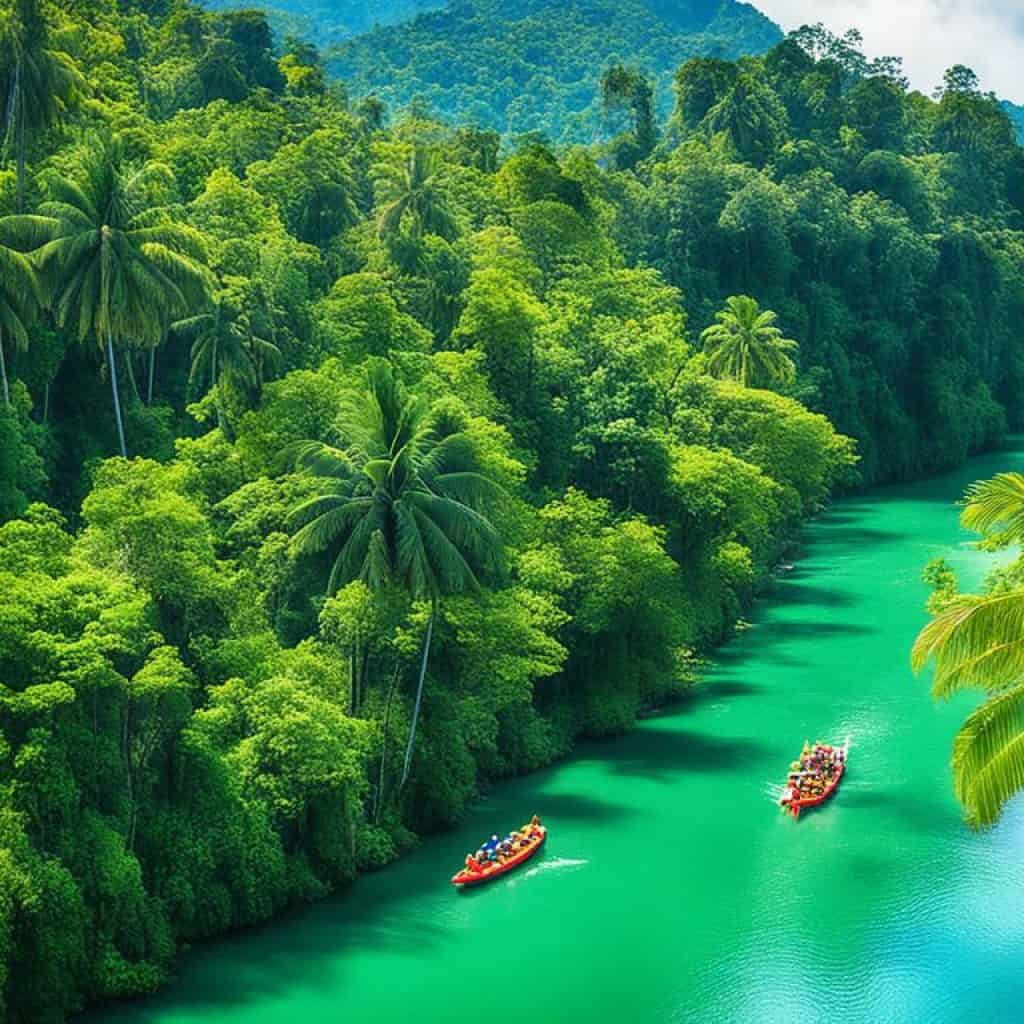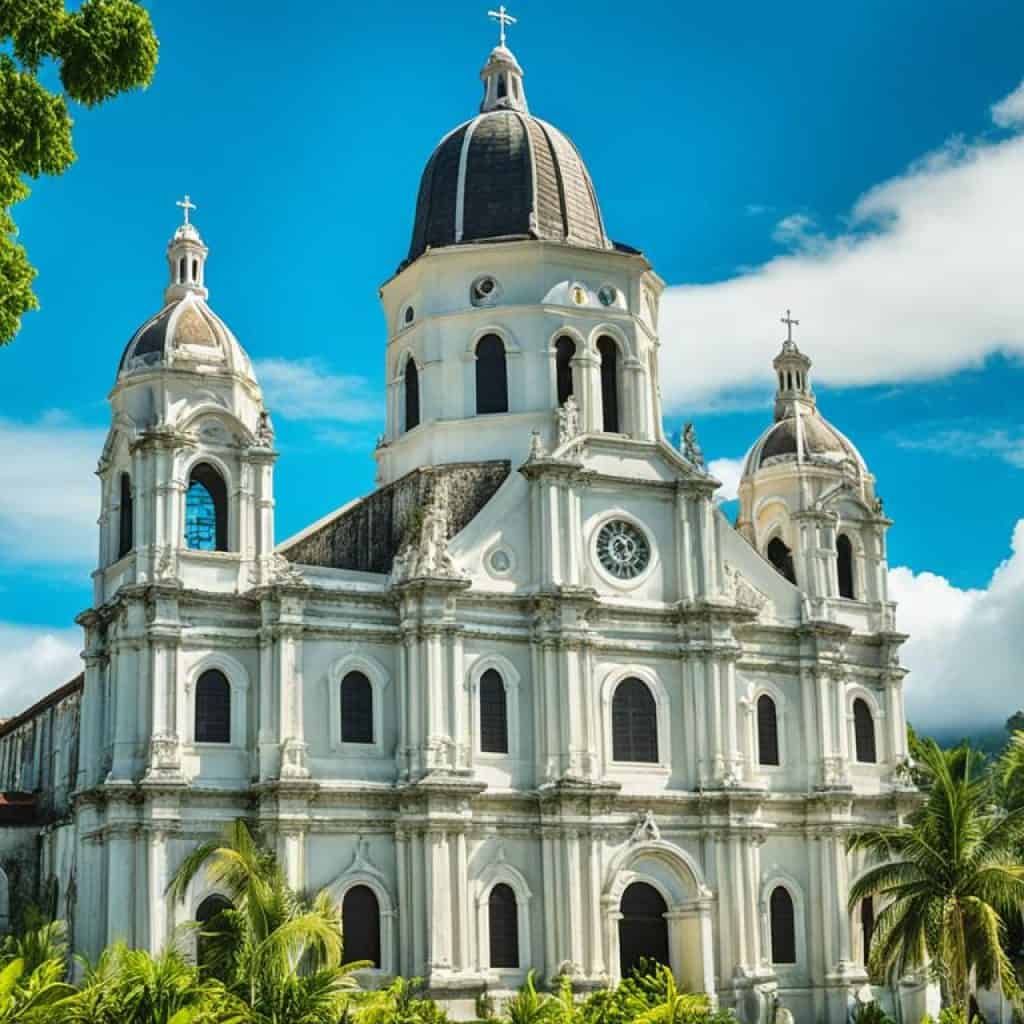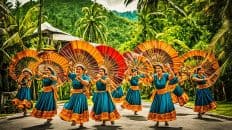Bohol, in the Philippines, is a gem filled with history and culture. It’s known for the Chocolate Hills and the tiny Philippine tarsiers. This island province draws those interested in history and culture.
Have you thought about the history behind Bohol’s famous sites? Or the events that created its rich culture? We will dive into Bohol’s history, discovering hidden stories and intriguing facts.
Key Takeaways
- Bohol is a province in the Philippines known for its rich historical and cultural heritage.
- From the Chocolate Hills to the Philippine tarsiers, Bohol offers a unique blend of natural wonders and historical significance.
- Exploring the historical sites in Bohol allows us to understand the events and people that shaped its legacy.
- Each landmark in Bohol has its own story to tell, contributing to the province’s unique tapestry of history.
- By exploring Bohol’s history, we gain a deeper appreciation for its cultural heritage and the importance of preserving it for future generations.
Historic Sites in Bohol
Bohol is a province in the Philippines that is rich in history and culture. It has many historic sites and landmarks. They tell the story of ancient civilizations, colonial influences, and local traditions. These have all played a part in making Bohol what it is today. These sites are great for anyone interested in history or just curious about the past. Exploring them takes you on a fascinating journey back in time.
“The past is not dead; it is living in us, and will be alive in the future which we are now helping to make.” – William Morris
Baclayon Church
Baclayon Church is one of the oldest Christian sites in the Philippines. It showcases Bohol’s enduring religious heritage. Located in Baclayon town, it flaunts 18th-century colonial architecture. It is considered a national cultural treasure.
Blood Compact Shrine
The Blood Compact Shrine is in Tagbilaran City. It marks a significant historical moment. It commemorates the first treaty of friendship between Datu Sikatuna and Miguel López de Legazpi in 1565. This ceremony symbolized a bond between the locals and the Spanish.
Loboc River
Visit the Loboc River to see Bohol’s vibrant culture and beauty. This landmark reflects the traditional Filipino way of life. You can go on a river cruise, enjoy scenic views, and listen to local musicians on floating restaurants.
Punta Cruz Watchtower
The Punta Cruz Watchtower in Maribojoc protected the area from pirates. This hexagonal tower offers views of the Bohol Sea. It reminds us of the region’s tumultuous past.
Tarsier Sanctuaries
Bohol is known for its Philippine Tarsiers, the smallest primates in the world. You can see them in sanctuaries in Corella, Sikatuna, and Loboc. These sanctuaries protect tarsiers and highlight Bohol’s biodiversity.
Loboc and Duero Churches
Loboc and Duero towns have beautiful churches. They show Filipino craftsmanship mixed with Spanish influence. Loboc Church is famous for its bell tower and frescoes. Duero Church has Baroque architecture and a storied history.
Mt. Carmel Hill
Mt. Carmel Hill in Balilihan has stunning views and historical importance. It has remains of a Spanish fort, showing Bohol’s past struggles and victories.
Clarin Ancestral House
The Clarin Ancestral House in Loay lets you step back in time. It shows the life of Bohol’s elite during colonial times. This ancestral house is a beautiful example of the era’s luxury.
Bohol’s historic sites take you back in time while celebrating its heritage. Each place provides a unique view of Bohol’s history and culture. They help us understand more about this province’s place in the Philippines.
The Legacy of Baclayon Church
Baclayon Church, constructed in the 18th century, is a national treasure in Baclayon, Bohol. This historic church is among the oldest in Bohol, holding great religious and cultural value.
This church shows off Spanish colonial architecture and detailed designs. Its walls have seen years of worship and change. This makes Baclayon Church a vital part of Bohol’s religious history.
Entering Baclayon Church takes you back in time. You’ll find peace in its beauty. The well-kept frescoes, altars, and bell tower tell stories of the past and the local people’s skills.
“Baclayon Church stands as a testament to the enduring faith and cultural heritage of the Boholanos.”
The church has been preserved and restored over time. Now, visitors see its impressive front, visit the museum, and join in services.
Baclayon Church is not just a building; it’s a community’s spiritual hub. It has seen numerous weddings, baptisms, and ceremonies that mark life’s significant moments for the Boholanos.
| Key Features of Baclayon Church | Historical Significance |
|---|---|
| Spanish colonial architecture | Declared a National Cultural Treasure |
| Exquisite altars and frescoes | A symbol of enduring faith |
| Elegant bell tower | Preserved heritage of Bohol |
A visit to Baclayon Church shows the Boholanos’ deep faith and traditions. Inside, history surrounds you, highlighting the lasting influence of Baclayon Church among Bohol’s historic churches.
Preserving the Cultural Heritage
Keeping Baclayon Church for the future is key. By valuing its role as a treasure and sanctuary, we aim to safeguard this vital part of Bohol’s religious history.
Blood Compact Shrine: A Symbol of Friendship
The Blood Compact Shrine in Tagbilaran City, Bohol, is very historical. It celebrates the first friendship treaty between Filipinos and Spaniards in 1565. This event was crucial in the Spanish colonization of the Philippines.
“Sandugo” or the blood compact, was a peace act. It joined the two cultures together. The Filipino leader, Datu Sikatuna, and the Spanish explorer, Miguel López de Legazpi, mixed and drank their blood.
“The Blood Compact Shrine is a testament to the enduring spirit of friendship and cooperation between the Filipino people and the Spanish colonizers during the early stages of Philippine history.”
The monument features grand statues and many details. It reminds us of this important event. It invites visitors to explore Bohol’s rich heritage and cultural legacy.
Locals and tourists visit the Blood Compact Shrine. It offers a place for quiet reflection. It’s perfect for learning how this event helped form the Filipino identity.
Exploring the Blood Compact Shrine
Approaching the shrine, you see statues of Datu Sikatuna and Miguel López de Legazpi. They are shown in the act of the blood compact. This sight fills you with awe.
The shrine is surrounded by greenery and faces the beautiful Bohol Sea. Strolling here, you can appreciate the site’s deep history.
This place is great for those interested in history or culture. It’s a chance to connect with the Filipino roots. It also shows the strong bond of friendship that influenced Philippine history.
We invite you to join us. Let’s discover more about Bohol’s historical sites, stories, and cultural treasures. This province is a real gem of Filipino heritage.
The Enigmatic Loboc River
The Loboc River is more than just a beautiful sight. A river cruise on the Loboc River lets you enjoy the lush greenery. It also shows you the traditional Filipino way of life.
The river flows through Bohol and tells the history and culture of the area. The Loboc River is a witness to the heritage and traditions of the Filipinos.
Taking a river cruise is like going back in time. The boat moves calmly, showing off stunning views. You’ll see local communities living their daily lives.
You’ll pass wooden houses on stilts, showing the locals’ toughness. You can smell the delicious food from riverside restaurants. They serve Filipino dishes made with fresh ingredients from around the area.
Listen to traditional music played by local musicians. Drums beat and colorful costumes add to the charm. It showcases the traditional Filipino lifestyle along the Loboc River.
Experiencing the Loboc River in Bohol is a must. It’s both beautiful and peaceful. And it teaches you about the culture and history of Bohol.

The Significance of Punta Cruz Watchtower
The Punta Cruz Watchtower is in Maribojoc, Bohol. It played a key role in history as a defense against pirates during the Spanish era. This watchtower is a symbol of the island’s fight and importance of protecting its shores.
It features stunning Spanish colonial architecture. Its hexagonal shape shows design skills from that time. It mixed strength, function, and beauty. Its solid build and position on a cliff’s edge made it an important lookout. It protected the Bohol Sea from pirate invasions.
At the top of the Punta Cruz Watchtower, visitors see an amazing view of the Bohol Sea. This view adds to the thrill of going back in time. It helps visitors dive into Bohol’s rich past. The place draws history lovers, architecture fans, and nature enthusiasts.
“The Punta Cruz Watchtower stands as a symbol of Bohol’s resilience and historical importance. Its design and strategic spot let us see into the island’s history.” – [Your Name], Bohol Enthusiast
A visit to the Punta Cruz Watchtower is a chance to see and learn about Bohol’s historical defense. It shows the island’s heritage and the spirit of its people. It played a vital role in protecting Bohol during colonial times.
| Key Highlights | Details |
|---|---|
| Location | Maribojoc, Bohol |
| Architecture | Spanish colonial |
| Historical Significance | Defense against pirates during the Spanish colonial period |
| Unique Feature | Hexagonal structure |
| View | Panoramic view of the Bohol Sea |
Make sure to visit the Punta Cruz Watchtower when in Bohol. It’s not just an architectural beauty but a peek into the island’s history. It shows how people long ago protected their home. Don’t miss seeing this historical gem.
The Mystical Charm of Philippine Tarsiers
The Philippine Tarsiers, one of the smallest and oldest primates, are central to Bohol’s ecology and culture. Their large eyes and long fingers create a sense of awe.
In Bohol, Tarsier Sanctuaries let visitors see these shy animals in the wild. These places help tarsiers survive and keep their species diverse.
The tarsiers in Bohol show the area’s rich nature. They also prove Bohol’s dedication to saving its unique environments.
The Tarsier Sanctuaries of Bohol
Bohol has Tarsier Sanctuaries important for the animals’ safety and public education. Visitors learn about tarsiers and help with their protection.
| Tarsier Sanctuary | Location | Features |
|---|---|---|
| Corella Tarsier Sanctuary | Corella, Bohol | – Natural habitat for tarsiers – Guided tours for visitors – Conservation education programs |
| Tarsier Conservation Area in Sikatuna | Sikatuna, Bohol | – Serene forest setting – Tarsier viewing platforms – Eco-tourism activities |
| Tarsier Conservation Area in Loboc | Loboc, Bohol | – Forest reserve for tarsiers – Educational exhibits – Research and conservation initiatives |
Visiting Tarsier Sanctuaries lets travelers see the beauty of these animals up close. It’s a chance to help with conservation in Bohol. It also allows visitors to experience the tarsiers’ magical charm.
Unveiling the Heritage of Loboc and Duero Churches
Two important landmarks shine in Bohol’s church history: Loboc Church and Duero Church. They show the history of the province. Their design mixes Filipino creativity with Spanish influence.
Loboc Church showcases the skill and commitment of Boholanos with its old bell tower and beautiful frescoes. It’s a symbol of the province’s religious strength and cultural history. Here, visitors can admire the art and feel the enduring faith.
Duero Church acts as a keeper of Bohol’s history. Its Baroque style and deep history tell of Bohol’s time under colonial rule. Inside Duero Church, it’s like going back in time. Its beauty shows the heart of Bohol’s religious history.
“Loboc Church and Duero Church are Bohol’s jewels, each showing different parts of the province’s church history. They are more than places to pray. They tell the story and culture of the Boholanos.”
A Comparison of Loboc Church and Duero Church
| Loboc Church | Duero Church |
|---|---|
| Age-old bell tower | Classic Baroque architecture |
| Stunning frescoes | Rich history |
| Reflective of Filipino creativity and Spanish influence | Silent guardian of Bohol’s past |
Exploring Loboc Church and Duero Church lets visitors dive into Bohol’s rich church history. They remind us of the province’s long story and its people’s ongoing faith.
Exploring Less-Known Sites: From Mt. Carmel Hill to Clarin Ancestral House
Bohol is famous for places like Baclayon Church and the Blood Compact Shrine. But it also hides some gems. One of them is Mt. Carmel Hill, known for its history and amazing views.
In Balilihan, Mt. Carmel Hill has a big historical role. It was a lookout for key events. Now, visitors can go up the hill. They will see beautiful landscapes that won locals and explorers’ hearts.
The Clarin Ancestral House in Loay is another hidden gem. It shows the rich life of Boholano elite during colonial times. The house has preserved architectural details and beautiful furniture. It reflects the grandeur of the past.
“Bohol’s hidden sites let us explore the island’s rich history and culture. From Mt. Carmel Hill’s views to the Clarin Ancestral House’s luxury, these places are waiting for explorers.”
Bohol has many other historical sites as well. Each has its own story and cultural worth. They enrich Bohol’s interesting past. Hidden churches and old ruins show Bohol’s history.
Lesser-Known Sites in Bohol
- Guiwanon Spring Park, Baclayon: A serene sanctuary where history and nature intertwine.
- Calunasan Church Ruins, Tubigon: Remnants of a once majestic church, now a hauntingly beautiful testament to the past.
- Presbyterian Church, Jagna: A charming church that blends Western and indigenous architectural elements.
- Carmen Church, Carmen: A quaint church worth visiting for its unique bell tower and religious artifacts.
Discovering these lesser-known sites in Bohol is a unique adventure. Each site opens a chapter of the island’s rich past. They give us a deeper understanding of Bohol’s proud cultural heritage.
The Beauty of Panglao Church
The Saint Augustine Church, also known as Panglao Church, is a stunning example of neoclassical architecture. It is located in Panglao, Bohol. This beautiful church draws visitors with its detailed carvings and impressive ceiling murals.
The church is more than a place for worship. It’s a showcase of art and history. It tells stories of faith through its architecture.
This church mirrors Bohol’s rich culture. Its construction shows the community’s strength and commitment. Once inside, you’re struck by its beauty and attention to detail. The Panglao Church stands as a beacon of faith and creativity in Bohol.
“The Panglao Church is not just a place of worship, but a living testament to the community’s unwavering faith and artistic vision.”
The wooden altar inside is a masterpiece. It grabs your attention with its fine carvings and religious figures. Look up to see the ceiling murals. They bring to life stories from the Bible and uplift the spirit.
In this peaceful setting, you feel deep respect. You think about the history and rituals here. The Panglao Church is a place for reflection and finding peace. It connects visitors with their spiritual side.
Neoclassical Architecture: A Harmonious Blend of Styles
The architecture of Panglao Church combines Greek and Roman styles with Filipino touches. It emerged in the 18th and 19th centuries. Spanish rulers favored this style.
The church’s facade has grand columns and a beautiful rose window. Each detail adds to its timeless elegance. Inside, graceful arches and ornate moldings showcase the neoclassical style. It is all about harmony and balance.
A Glimpse into Bohol’s Rich Religious Heritage
Panglao Church is a window into Bohol’s religious past. It is a place for both believers and history fans. They can explore the origins of Catholicism in the region.
For years, this church has been central to the community. It hosts religious events and festivals. These gatherings unite people in celebration of their faith and history.
Visiting Panglao Church: A Memorable Experience
Visiting Panglao Church is unforgettable. You’ll be moved by its stunning design, meaningful art, and quiet atmosphere. It’s a deep dive into Bohol’s religious and cultural roots.
This church appeals to many visitors. Whether you love history, art, or are seeking peace, it welcomes you. Here, you feel the strength of faith, the community’s determination, and the lasting appeal of neoclassical design.
| Key Features | Information |
|---|---|
| Location | Panglao, Bohol |
| Architectural Style | Neoclassical |
| Year of Construction | 1894 |
| Ceiling Murals | Breathtaking depictions of biblical scenes |
| Special Highlights | Intricately carved wooden altar, rose window |
Cortes Church: A Blend of Art and Faith
In the lovely town of Cortes, Bohol, the magnificent Santo Niño Church stands proud. It’s a symbol of the area’s deep religious roots and stunning architectural skill. Visitors are drawn to its unique mix of styles and cultural importance.
Cortes Church harmoniously blends local and colonial designs. Its front showcases beautiful carvings that demonstrate Filipino craftspeople’s skill. The Baroque bell tower, with its elegant shapes and decorative flourishes, highlights its architectural beauty.
Entering Cortes Church, a peaceful vibe welcomes all. Inside, amazing murals and cherished religious figures showcase years of pious devotion. Every art piece, from brushstrokes to fine lines, shares a tale of faith and strength.
“The Cortes Church is more than a prayer place; it represents Boholanos’ artistic and spiritual legacy. Its design and indoor decorations are a vivid proof of the locals’ deep faith and dedication.”
An Architectural Journey through Time
Cortes Church stands out because of its varied architectural styles. It mainly features Baroque style, but you can also see neoclassical and local influences. This blend signifies how architectural trends have evolved.
The church’s chancel, with its superb decor and altar, is quite striking. The pulpit, featuring detailed carvings, is an eye-catching marvel. Stained glass windows cast colorful lights inside, creating a magical atmosphere.
A Place of Reverence and Community
The Cortes Church means much to locals, being a central spot for spiritual and cultural gatherings. It hosts year-round celebrations, reflecting its deep religious and community role.
More than its architectural splendor, the church cultivates a strong community through vibrant festivals and ceremonies. The Cortes Church symbolizes unity and faith, joining people’s hearts and spirits together.
| Key Features | Architectural Style | Influence |
|---|---|---|
| Baroque Bell Tower | Baroque | Spanish Colonial |
| Ornate Interior | Baroque | Spanish Colonial |
| Indigenous Carvings | Indigenous | Filipino Craftsmanship |
| Neoclassical Elements | Neoclassical | European Influence |
Visiting Cortes Church lets you delve into faith, art, and history. It mirrors the Boholanos’ enduring spirit and creativity, leaving everyone amazed by its beauty and spirituality. For those keen on connecting with Bohol’s culture, Cortes Church is an essential visit that showcases architectural artistry and prompts divine reflection.
Calape Church: Gothic Beauty in Bohol
Calape Church, known as San Vicente Ferrer Parish, showcases Gothic architecture in Bohol. Built by the Recollects, it highlights the area’s rich history and culture.
The church’s design features pointed arches, stone carvings, and detailed work. Its Gothic elements show through in its spires and stained glass windows. These elements contribute to its grand look.
Inside, you’re greeted by a tall nave, ribbed vaults, and thin columns. This creates a special feeling, with light and shadow adding mystery.
The church also has a historic bell. It goes back centuries and connects us to past worshippers. This bell represents faith and the resilience of Bohol’s people through time.
“The Calape Church is more than a worship space; it reflects Bohol’s architectural skill and religious passion.”
Visiting the church lets you experience Gothic beauty and Bohol’s cultural depth. It is a landmark of history and architecture, captivating all who visit.
Discover the beauty of Calape Church. Admire its high spires, attention to detail, and the historic bell. It stands as a proud symbol of Bohol’s churches’ beauty and historical depth.
Loay Church: A Cultural Gem
The Holy Trinity Church, often known as Loay Church, is a cultural treasure in Bohol. It shows a fascinating mix of architectural styles. It also holds great historical significance. This beautiful church is a sign of the region’s rich culture. It draws people from all over the world.
Loay Church is famous for its neoclassical architecture. It mixes classical and modern design beautifully. The church’s front has intricate details and decorations. These make it a stunning sight. Its beauty and elegance show Bohol’s rich architectural heritage.
Inside the church, there’s lots to see and feel. The interior has stunning artworks, like religious paintings and sculptures. These are stunning to look at and full of religious and cultural meaning. The art and skill inside the church show the local community’s devotion and creativity.

The Historical Significance of Loay Church
“The Loay Church stands as a testament to the rich cultural heritage of Bohol and serves as a beacon of faith and spirituality for the local community.”
Loay Church is not only beautiful but also historically important. It’s one of Bohol’s oldest churches, dating back to the 18th century. It has survived natural disasters and cultural changes. This church offers a peek into the region’s history and faith’s lasting legacy.
For locals and visitors, Loay Church is more than a worship place. It’s a cultural landmark that shows the Boholano people’s resilience, tradition, and respect. It proves their strong beliefs and their goal to keep their cultural heritage alive for future generations.
Preserving the Cultural Legacy
Loay Church reminds us of the need to protect and preserve our heritage. Efforts are in place to keep and take care of the church. This way, future generations can enjoy its beauty and historical importance.
It’s crucial for communities and groups to work together. They must protect and promote Bohol’s cultural landmarks, like Loay Church. Doing this will make sure these places keep inspiring and teaching us. It’ll help us appreciate our rich history and cultural diversity.
Balilihan Church: A Fusion of Architectural Styles
Balilihan Church is more than a place for worship. It is an architectural wonder. It displays a mix of styles. The church is in Balilihan, Bohol. It shows the rich culture and unique charm of the area.
The church’s design combines various architectural elements beautifully. It features Corinthian columns, Neo-Gothic spires, and Baroque volutes. This blend gives the church a unique and eye-catching look. It stands out among Bohol’s other churches.
The Corinthian columns add elegance. They have decorative capitals and are slim. The carving of acanthus leaves on them brings luxury and sophistication.
The Neo-Gothic spires bring height and drama. They have pointed arches and detailed tracery. This style honors the Gothic tradition of tall structures and elaborate designs.
Baroque volutes are also part of the church’s design. They look like scrolling shapes. Found in Baroque architecture, they bring energy and flow to the church’s front. This makes the church look more appealing.
Inside the church, there’s a mix of styles too. You’ll see detailed altarpieces and stained glass windows. There are also beautiful religious art pieces. All these create an enchanting space. It invites visitors to enjoy the religious and artistic heritage.
Balilihan Church shows the skill and creativity of its creators. It blends styles well, creating a united design. This mix of styles reflects the various influences on Bohol’s culture through time.
Visiting the church offers a spiritual journey and a chance to see Bohol’s architectural gems. The blend of styles makes it uniquely charming and captivating.
Architectural Elements of Balilihan Church
| Architectural Style | Description |
|---|---|
| Corinthian columns | Elegantly carved columns with acanthus leaf capitals, evoking classical beauty and grandeur. |
| Neo-Gothic spires | Tall, pointed spires with intricate tracery, adding verticality and drama to the church’s silhouette. |
| Baroque volutes | Decorative scroll-like shapes that add movement and dynamism to the façade of the church. |
Conclusion
Our trip to Bohol’s historic sites was an amazing journey. We explored the island’s history and culture. The Chocolate Hills and the Philippine tarsiers were highlights of our adventure.
We leave with a greater respect for the stories of these landmarks. Places like Baclayon Church and Loboc River touched our hearts. Each site we saw added to our experience.
Bohol’s history is more than just facts. It shows the strength, creativity, and faith of its people. We must explore, enjoy, and also protect these wonders for the future.
We hope more people will get to see Bohol’s historic beauty. Let’s all work to keep the island’s culture and history alive. It’s what makes Bohol so special.
FAQ
What historical sites can I visit in Bohol?
What is the historical significance of Baclayon Church?
What does the Blood Compact Shrine symbolize?
What is special about Loboc River?
What is the historical significance of Punta Cruz Watchtower?
What is the significance of Philippine Tarsiers in Bohol?
What makes Loboc and Duero Churches noteworthy?
What can I expect to see at Mt. Carmel Hill and Clarin Ancestral House?
Tell me about Panglao Church and Cortes Church.
What is special about Calape Church?
What makes Loay Church unique?
What can I expect to see at Balilihan Church?
Source Links
- https://wetravelphilippines.com/bohol-tourist-spots/historic-sites-in-bohol/
- https://www.agoda.com/travel-guides/philippines/bohol/bohols-heritage-tour-a-walk-through-centuries-old-churches-and-structures/
- https://theadventuristtraveler.com/south-east-asia-travel/philippines/exploring-bohol-history-natural-beauty-and-culinary-delights/


















Add comment